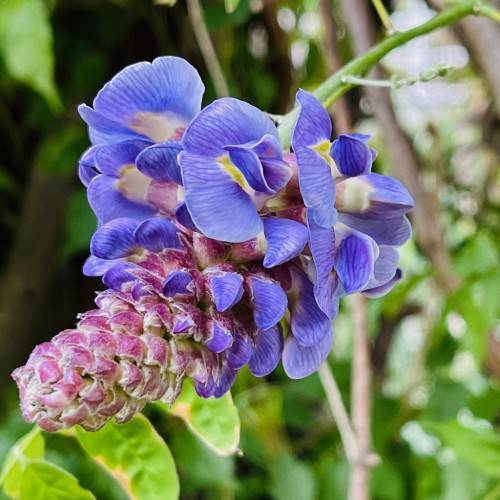
wisteria
Wisteria macrostachya 'Blue Moon'
Cycle:
Perennial
Watering:
Average
Hardiness Zone:
3 - 9
Flowers:
Flowers In Summer
Sun:
Full sun
Leaf:
Yes
Growth Rate:
Low
Maintenance:
Moderate
Invasive:
Yes
Care Level:
Medium
watering
Wisteria (Wisteria macrostachya 'Blue Moon') requires regular watering, and should be watered whenever soil appears dry to the touch near the surface. During the summer months, it is best to water the plant every 2 to 3 days, giving it a good soaking and allowing the soil to dry in between waterings. In the spring and fall, water moderately and only when necessary. During the winter months, water your Wisteria every 2 to 4 weeks, as the plant is dormant at this time of year.
sunlight
Wisteria macrostachya 'Blue Moon' is a sun loving plant that prefers 8-10 hours of full sun per day. It does best when planted in an area that receives direct sunlight for most of the day, but can tolerate some afternoon shade in warmer climates. This specific variety of wisteria needs to be planted in an area that receives at least 6 hours of direct sunlight in order to produce the best blooms. During periods of extreme heat, it is important to provide afternoon shade to give this plant some relief.
pruning
Prune wisteria (Wisteria macrostachya 'Blue Moon') twice a year. First pruning should take place in winter, just after flowering, to keep the plant compact and encourage a better display of flowers next season. Remove any weak or excessively long shoots and shorten main branches back to healthy lateral shoots. The second pruning session should take place in late spring/early summer and is to selectively shorten certain shoots to control growth and keep the plant tidy.
Season
Hardiness Map
FAQ
Is Wisteria a hardy plant?
Yes, Wisteria is a hardy plant. It is tolerant of a range of soil types, temperatures and humidity levels, making it an ideal choice for a variety of landscaping projects. Its hardy nature also allows it to survive in both the shade and the sun, and it can even be grown in containers. Wisteria does require regular pruning to keep it under control and encourage better flowering, but this is a simple task for experienced gardeners.
Are Wisteria flowers fragrant?
Yes, wisteria flowers are highly fragrant. They have a sweet, heady scent, which is said to be strongest in the evening and in warm climates. The flowers come in a variety of colors and can grow in a range of shapes, from long, drooping clusters to small, pea-shaped flowers. Even though it has been known to sometimes have an unpleasant scent, overall, the lovely and sweet aroma of wisteria flowers make them a favorite with gardeners.
Could Wisteria be grown in a container?
Yes, wisteria can be grown in a container. For best results, choose a container with ample drainage holes, as wisteria need a lot of water. Make sure that the soil you plant in the container is rich and well-draining. Place the wisteria in an area that gets plenty of sunlight as wisteria need full sun exposure. Additionally, Wisteria will need to be pruned regularly to keep it an appropriate size for the container.
Do Wisteria plants require a trellis or support structure?
Yes, wisteria plants require a trellis or support structure in order to properly grow. The vine-like branches of a wisteria need to be encouraged to climb vertically. A trellis or supported structure is needed in order to do this. In addition, a trellis or support structure also stabilizes these weak stems, as they can be broken easily in strong wind or rain. It is best to choose a tool with straight unknotted edges and secure the stem of the plant to the trellis with wire ties or rope. Once the trellis is secured in the ground, tie it to the stem of your wisteria for the best results.
Is Wisteria deer-resistant?
No, unfortunately Wisteria is not deer-resistant. In fact, deer tend to love the sweet taste and easily accessible flowers of the Wisteria plant. Deer are notorious for snacking on perennials and Wisteria is no exception, so if you have a problem with grazing deer in your area, it is recommended that you opt for a different flowering plant.
Could Wisteria be grown as a groundcover?
Yes, wisteria can be grown as a groundcover. It grows quickly, trailing up to thirty feet in length in one year. It will create a beautiful dense foliage groundcover when left to its own devices, or can be trained and pruned if you want to control its size. It will also provide fragrant blooms in the spring. Wisteria is easy to grow, but it is incredibly important to pay attention to its water and light needs or else it will fail to thrive.
Do Wisteria vines damage buildings or other structures?
Yes, Wisteria vines can damage buildings and other structures. The vines can grow quickly and become large, causing them to put heavy pressure on walls and other structures they cling to. The pressure can cause the structures to crack and weaken, creating structural damage and potential safety hazards. Additionally, Wisteria can send roots into cracks in walls and mortar, further destabilizing the structure. Finally, the thick growth of the vines can sometimes cause water damage if water is able to form and collect on the vines and eventually seep into walls or other areas.
Could Wisteria be grown indoors as a houseplant?
Yes, wisteria can be grown indoors as a houseplant. This hardy vine does best in bright, indirect sunlight, and plenty of humidity. When grown indoors, its size is more containable, so it won't overpower your space. Training wisteria vines to climb supports, such as trellises or basket stands, is advised. Additionally, regular pruning is necessary to contain the size, encourage flowering, and reduce the chances of any pot bound roots. With their hanging flowers and fragrant scent, wisteria can be a beautiful addition to any home.
